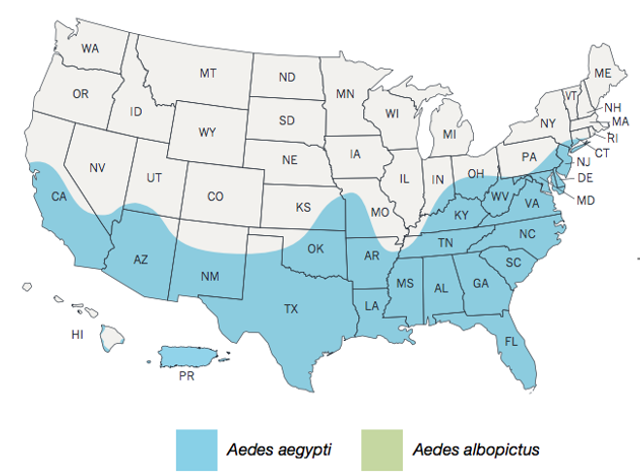David Brown
On Tuesday, the US Senate failed to vote on the latest bill to provide funding to fight the Zika virus in the United States, essentially preventing any significant government response during the summer months as the mosquito populations that spread the disease boom. Both the House and Senate are heading into their Fourth of July holiday breaks and will reconvene just briefly before going into summer recess until the middle of September.
The Zika virus, which is responsible for a surge of birth defects like microcephaly in Brazil, is currently sweeping through the US territory of Puerto Rico and has the potential to spread to mosquito populations on the mainland where it is currently only sexually transmitted.
The White House requested $2 billion to fight the virus four months ago, and government health agencies have been carrying out minimal work with roughly $600 million that the Obama administration has shifted from Ebola funding since then. The Senate Democrats filibustered a Republican bill that would have provided $1.1 billion but also cut $540 million from Affordable Care Act funding, and prevented any Zika funding from going to Planned Parenthood.
The Republican bill would have required all Zika funding to go to public health departments and Medicaid-run clinics, excluding any private health centers such as Planned Parenthood. This would significantly impede efforts to halt the epidemic in Puerto Rico where only 12 of the island’s 78 municipalities have a Medicaid-run facility.
 Extent of Aedes Aegypti in the United States, the main carrier of Zika
Extent of Aedes Aegypti in the United States, the main carrier of Zika
The inability of Congress to even minimally address the epidemic threat is indicative of the broader crisis in American politics. The sum of money they have debated over for four months without resolution is a little more than the daily budget of the US military or approximately 0.2 percent of the cost of President Obama’s proposed overhaul of the US nuclear arsenal.
In the meantime the Zika virus has spread throughout Puerto Rico where an estimated 2 percent of the adult population is catching the disease each month and the US Center for Disease Control (CDC) estimates a full quarter of the island’s 3.5 million people will be infected with the virus by the end of the year. Roughly 32,000 babies are born in Puerto Rico each year and infected pregnant women pass the disease to their children in utero leading to sharp increases in birth defects.
The director of the CDC estimates that lifetime care of a child born with microcephaly, the most notable effect of fetal Zika infection, can range between $1 million and $10 million. Puerto Rico is currently facing a bankruptcy crisis that has seen massive cuts to its health care system as well as long term unemployment and widespread poverty. Many new parents will be unable to afford medical care for their newborns.
According to the CDC, there are currently 2,026 confirmed cases of Zika in US territories where the virus is spreading by mosquito bite and 935 cases in the US mainland that are either from people contracting the disease abroad or from having sex with those who have. A total of 537 pregnant women have contracted the virus and there have been at least 8 cases of Zika-related microcephaly or other congenital malformations.
Although microcephaly, a condition where an infant has an abnormally small head, is the most obvious impact of Zika infection, recent research from Brazil shows the virus causes a wider range of congenital brain damage. One in five infants suspected of contracting Zika in the womb had head sizes in the normal range but were still likely to have significant brain abnormalities.
Microcephaly is strongly correlated with an infection early in the pregnancy while normal head sizes with other problems are associated with third trimester infection. There is no point during pregnancy where an infant is safe from severe effects. Doctors have not yet determined how old a child has to be for Zika to no longer significantly impact the development of their brain.
Zika infection is associated with vision and hearing problems, as well as limb malformations. It is entirely possible that the virus, which is known to target brain and nerve cells, could have a subtler long-term impact on those infants who do not suffer an immediately obvious problem.
 Extent of Aedes Albopictus in the United States, a mosquito also know to carry Zika
Extent of Aedes Albopictus in the United States, a mosquito also know to carry Zika
Although Brazil is the epicenter of the current outbreak, there is active mosquito-borne transmission in 63 countries and person-to-person infection in another 10. To coordinate the global response, the World Health Organization has asked for $122.1 million in special funding through December 2017. In the first six months of 2016 they have received just over $4 million, with the largest donor, Norway, giving $1 million.
Brazil, where over 1 million people have been infected with Zika, is planning on hosting the Olympic Games in August. Should any of the expected half a million foreign tourists introduce Zika into the mosquito populations of their home countries, the epidemic could spread much further. In countries with poor health care and sanitation, the disease can spread unseen for nearly a year, as it did in Brazil, until the unmissable impact on newborns is seen.
Over 2 billion people live in the range of the main vector of the Zika virus, the Aedes Aegypti mosquito. Within the US this encompasses the Southern states as well as those bordering Mexico. Another, more cold resistant mosquito, Aedes Albopictus, was recently confirmed to carry the Zika virus in Latin America, and extends the reach of the virus in the United States into the Midwest, as far as southern Minnesota.
No comments:
Post a Comment